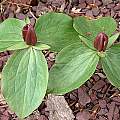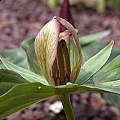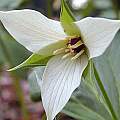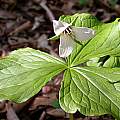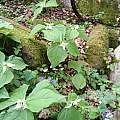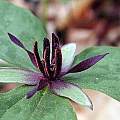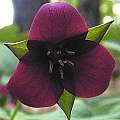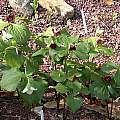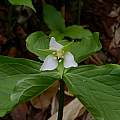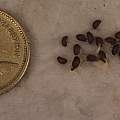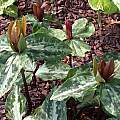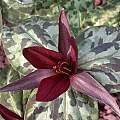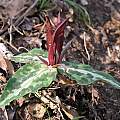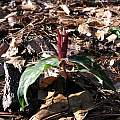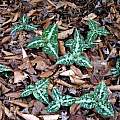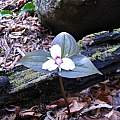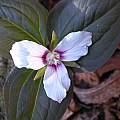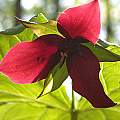Trillium is a genus in the Trilliaceae family with 43 species, with 38 in North America and 5 in Asia. The leaves, petals, and sepals come in parts of 3 and are indicative of the genus name. Plants grow from thickened rhizomes. They are mostly woodland plants that require shade and humus rich soil. Much of the information on this page supplied by John Lonsdale from his article on Trillium from Bulbs, Bulletin of the International Bulb Society, Spring 2004. The article describes many of the species of trillium found in the eastern USA and includes information on cultivation and propagation. Trillium species s through z are found on this page.
Trillium a-f - Trillium g-r - Trillium index
Trillium sessile L. is native to the north central and east central United States. It is frequently misrepresented in cultivation; most of the plants bought or seen under this name actually correspond to T. cuneatum or one of the western sessiles, although the true plant is of much smaller stature than any of these. It can be a charming plant and very fine forms with excellent leaf mottling and petal color can be found. In particular, I have seen yellow plants, and those with yellow flowers edged with purple, creating a very attractive picotee effect. Photos by John Lonsdale.
Trillium simile Gleason is native to North Carolina, Tennessee, and Georgia, United States. It is a very attractive large species, often forming small clumps, with erect creamy-white flowers (normally) with a purple ovary. The flower is characteristically more funnel-shaped with the ends of the petals flaring sideways. First two photos by John Lonsdale. The last photo is taken by Nhu Nguyen taken in the Great Smokies National Park.
Trillium stamineum Harb. is a medium sized species with relatively small flowers, the fragrance of which can be rather unpleasant. However, the thin dark maroon petals are horizontally inclined and uniquely twisted along their length. Less clump forming than its two relatives, it is found in central and western Alabama, eastern Mississippi and west-central Tennessee. Photo by John Lonsdale.
Trillium sulcatum T.S.Patrick is native to these states in the United States: Alabama, Georgia, Kentucky, North Carolina, Tennessee, Virginia, West Virginia. It is a large showy species with dark red-maroon to purple flowers with broad petals that are slightly flatter than those of Trillium simile. Occasional white, pink cream and yellow forms can be found together with beautiful bicolors and picotees. Photos by John Lonsdale.
Trillium tschonoskii Maxim. is a small species from Japan and the Himalayas. Photo by Mari Kitama taken in Japan. Picture of seeds starting to grow in mid-July in England by David Pilling.
Trillium underwoodii Small is virtually impossible to distinguish from Trillium decipiens in non flowering plants. The major difference is one of stature of flowering plants, and the ratio of leaf length to stem height. In T. underwoodii the stems are 3" to 8" tall and 1 to 1.5 times the leaf length, whereas in T. decipiens the ratio increases to over 3, the leaf size remaining similar. Photos by John Lonsdale, Alani Davis, and Jay Yourch. This species is native to the states of Alabama, Florida, Georgia (United States).
Trillium undulatum Willd., the Painted Trillium, has a broad range in the eastern parts of the United States and Canada, from Georgia north to Ontario and Quebec, following the Appalachian Mountains. In some states, it is listed as endangered. In the wild it is found in humus rich, acidic soil in a shady area. In cultivation, it does well in open woodlands where the soil remains moist in the summer. It takes 2-3 years for plants to flower from seeds. Transplanting should be done while plants are in flower. Photos by Nhu Nguyen.
Trillium vaseyi Harb. is a spectacular species native to the southeastern United States with huge (up to 3" across) flowers of deep red-maroon nodding below the leaves. White flowered forms are known and it is the last species to flower here. Photo by John Lonsdale. See pictures of hybrids of it with Trillium rugelii.
Trillium a-f - Trillium g-r - Trillium index
